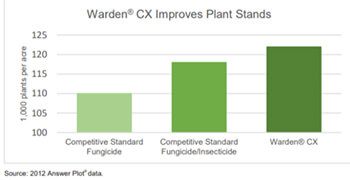Plan Now for Double-Crop Soybean Success
Jun 01, 2020

As the 2019-20 wheat crop continues to mature, now is a good time to start thinking about strategies to establish a successful soybean crop once the wheat is harvested. While we have enjoyed superb double-crop soybean yields in recent years, in any given year this cropping system can present numerous challenges.
Here are some things to consider as you make your plans for planting double-crop soybeans.
Variety selection is crucial. Selecting a soybean with characteristics consistent with double-crop performance is an important part of the planning process. A defensive type variety that has good height potential will usually perform best in these situations. Croplan has some good options, including RX4810S and RX5010S.
Adjust planting populations upward. Often farmers will increase planting populations in late or double-crop planting situations. One reason for this is they realize the optimum planting window (and often times adequate soil moisture) is quickly disappearing. Another reason is that “crowding” will promote height in a young growing soybean crop, which can help close canopies more quickly and conserve soil moisture during critical times.
Seed treatments can make all the difference. Growers sometimes have a tendency to back off of seed treatments as the season progresses, citing better growing conditions for seedlings. The reality is that some seedling diseases like Phytopthora are actually more of a threat in warmer weather. We at Co-op recommend Warden CX for all double-crop planting situations. Studies have shown again and again that this product improves soybean plant stands, which is critical when a replant could prove disastrous.
Residue management is key. One of the biggest challenges farmers face when planting double-crop beans is dealing with the residue left from the recently harvested wheat crop. Hair pinning is a term used to describe a situation where disc openers can’t slice through the wheat straw and instead bends and pushes it down into the seed trench, leading to inadequate trench closure and moisture wicking. Planting slow with heavy-down pressure and perhaps adding notched disc openers are two methods to help combat this problem.
Don’t forget residual herbicides. One of the biggest weed problems in double-crop beans can be volunteer wheat that emerges after post-harvest rains. At a time when moisture can start to get scarce, don’t give weeds a chance to rob your young crop. To combat this, farmers can benefit from applying a burndown herbicide with both broadleaf and grass residual herbicides at the planting of double-crop beans.
If you have questions about double-crop soybeans or any other topic, don’t hesitate to contact your local Co-op agronomy professional. These experts are always eager to partner with you to help you achieve your goals!
Here are some things to consider as you make your plans for planting double-crop soybeans.
Variety selection is crucial. Selecting a soybean with characteristics consistent with double-crop performance is an important part of the planning process. A defensive type variety that has good height potential will usually perform best in these situations. Croplan has some good options, including RX4810S and RX5010S.
Adjust planting populations upward. Often farmers will increase planting populations in late or double-crop planting situations. One reason for this is they realize the optimum planting window (and often times adequate soil moisture) is quickly disappearing. Another reason is that “crowding” will promote height in a young growing soybean crop, which can help close canopies more quickly and conserve soil moisture during critical times.
Seed treatments can make all the difference. Growers sometimes have a tendency to back off of seed treatments as the season progresses, citing better growing conditions for seedlings. The reality is that some seedling diseases like Phytopthora are actually more of a threat in warmer weather. We at Co-op recommend Warden CX for all double-crop planting situations. Studies have shown again and again that this product improves soybean plant stands, which is critical when a replant could prove disastrous.
Residue management is key. One of the biggest challenges farmers face when planting double-crop beans is dealing with the residue left from the recently harvested wheat crop. Hair pinning is a term used to describe a situation where disc openers can’t slice through the wheat straw and instead bends and pushes it down into the seed trench, leading to inadequate trench closure and moisture wicking. Planting slow with heavy-down pressure and perhaps adding notched disc openers are two methods to help combat this problem.
Don’t forget residual herbicides. One of the biggest weed problems in double-crop beans can be volunteer wheat that emerges after post-harvest rains. At a time when moisture can start to get scarce, don’t give weeds a chance to rob your young crop. To combat this, farmers can benefit from applying a burndown herbicide with both broadleaf and grass residual herbicides at the planting of double-crop beans.
If you have questions about double-crop soybeans or any other topic, don’t hesitate to contact your local Co-op agronomy professional. These experts are always eager to partner with you to help you achieve your goals!